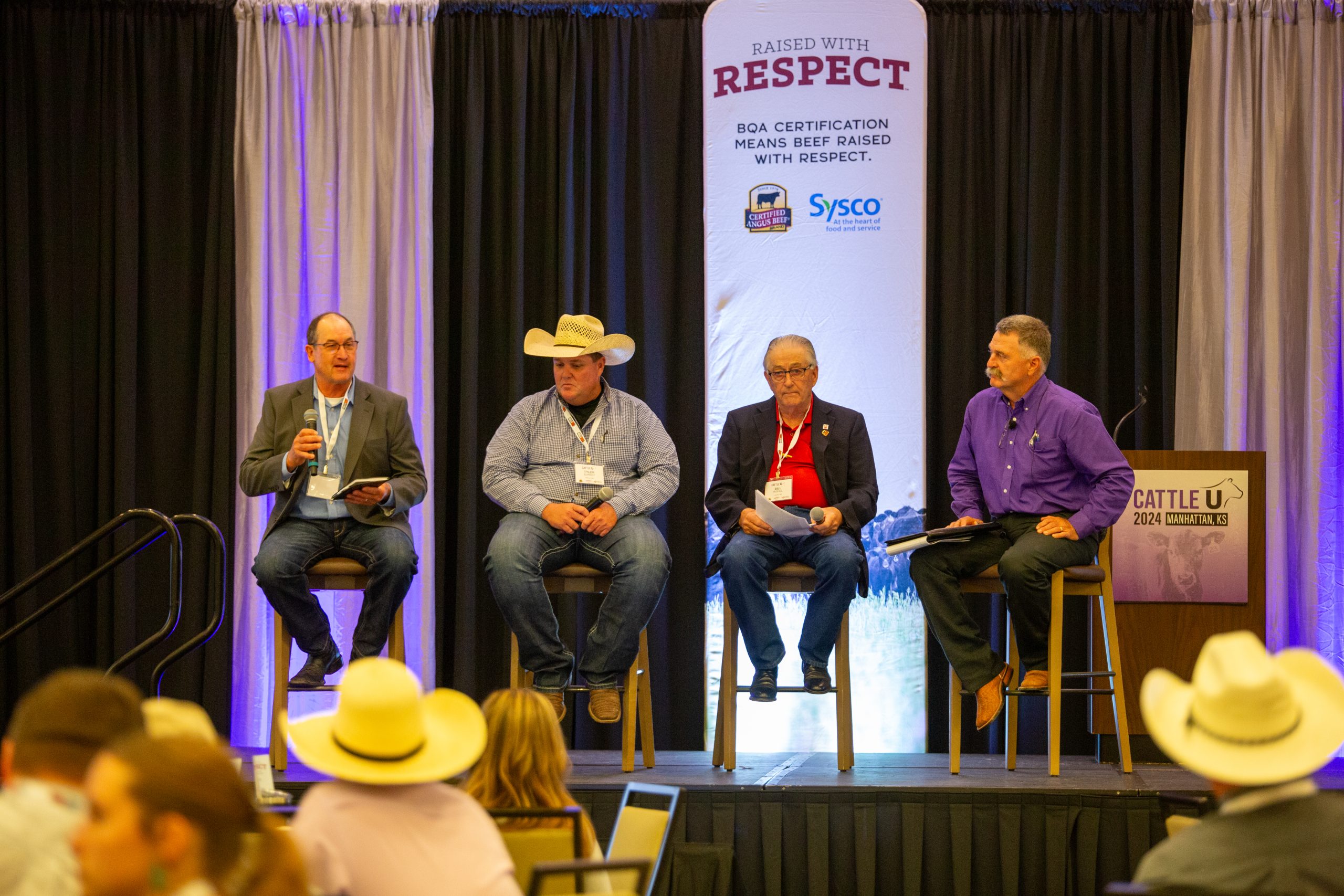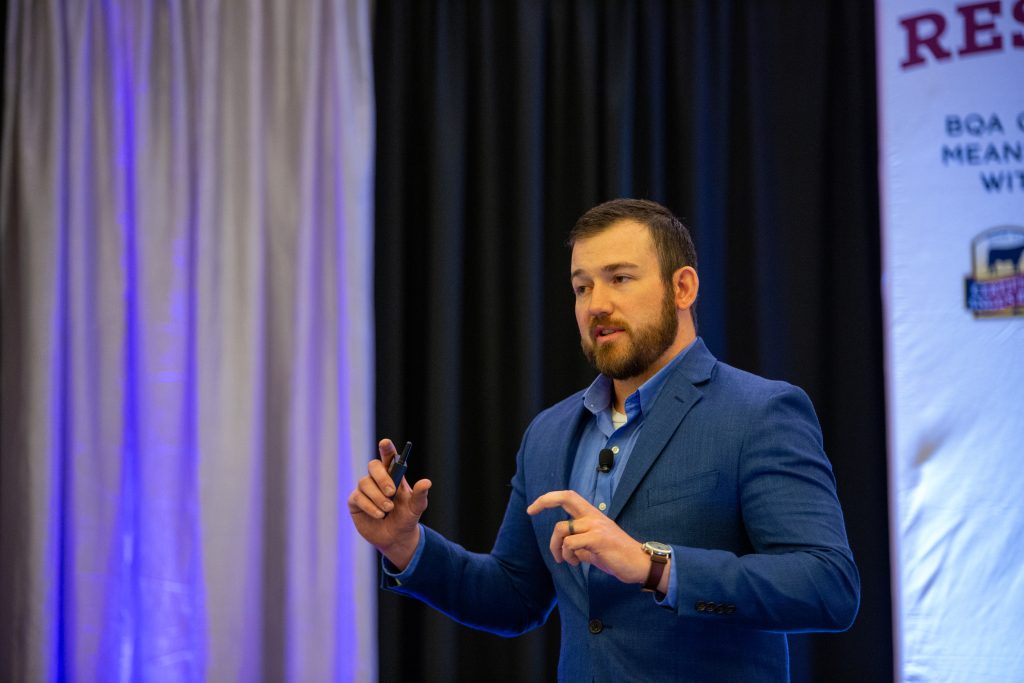Keynote, producer panel highlight past, present and future of beef industry

At Cattle U, the keynote speaker and the producer panel are normally crowd favorites. Terrel Platt’s Cattle Market Outlook and the Producer Panel led by Mark Gardiner and featuring panelists Mark Diederich, Tyler Burkey and Bill Rishel at this year’s event June 25 in Manhattan, Kansas, proved no different.
Platt, an analyst with CattleFax, discussed the ups and downs of the cattle market as well as current market supply and demand fundamentals, implications of cattle prices and what profitability is looking like. He also touched on herd expansion and recovery as well as what demand and growth look like.
For the last five or six years, the beef industry has been in a liquidation phase and Platt sees that continuing through 2024.
“We’ve obviously seen a huge increase in prices, he said. “We also haven’t had a massive drawdown in fed slaughter.”
There was a big draw down in fed numbers last year, but has moderated some in 2024.
“But we’ve already seen the big upturn in prices,” Platt said. “As we go through here and start to move towards that expansionary phase we will start to build that supply. .”
When looking at the industry from a “bigger picture perspective,” Platt said U.S. beef producers are poised to take advantage.
“I think it’s a testament to our commitment to animal husbandry practices, investing in genetics investment in different practices that allow us to be so efficient because we’ve been able to actually achieve record beef production with some of the fewest cow numbers dating back to the 1950s,” he said. “Now we’re starting to see some of these cycles take shape.”
Productivity is important

Platt expects from an expansionary standpoint, inventory levels are not likely to reach 2019 levels as a result of increased productivity.
It’s hard not to talk about market expectations and supply without spending time on the weather. Drought limits forage production, and at the end of June, levels are better than expected, he said, in noting drought pockets in New Mexico, west Texas and southwest Kansas. Those areas with drought pressure are likely the ones who have been hindered by it the last few years, and have culled their herds already.
Platt does see the liquidation trend still being intact, and it points to even tighter supplies continuing into 2025 and 2026.
“Demand is historically strong, but we need to watch employment and watch consumer inputs and make sure we don’t see some negative impacts,” he said. “Annual average rent prices can be higher and that correlates back to our cattle and feeder prices.”
But producers shouldn’t get too excited about the record prices, and it’s a time to still be prudent with expenses and the money going out the door.
“I think having those basic plans and evaluating the amount of equity that you guys have for balance sheets today is a prudent step to take,” he said. “Do not necessarily have a plan for the good years, but what do—I have as a plan for when things might not be always be as friendly as they are.”
Producer panel
Moderator for the producer panel, Ashland, Kansas, rancher Gardiner said when looking at agriculture, producers need flexibility. Panelist Diederich is doing that. He has a cow/calf to finish operation in Washington County, Kansas, grazing native grass, cover crops, grazers and crop residue.
A number of years ago Diederich was able to purchase some cows from Texas because of drought conditions in that state, and since he’s learned how to better feed cattle in confinement. He recommended having the right equipment and if it too expensive to buy find a way to build it.
Cattle will waste hay and eventually waste too much of it. Diederich found a solution and ended up building his own feed box. He also found it was cheaper to grow something and have the cattle graze it instead of hauling it to them. He’s also found it is more efficient to have cattle that are easy to catch and they have a docile temperament.
“Before we started playing with this deal, we took a couple three good quarter horses, a feed truck and a four-wheeler (to gather),” he said. “Docility is huge, and it is something that is very transferable and I don’t care what breed it is.”
Be open to new ideas
Burkey doesn’t have to contend with the age-old mantra of “we’ve always done it this way” that many in production agriculture have to wrestle with. He’s the co-owner of 1901 Trading Co., a reality and media company, in addition to Burkey Hay Co., a livestock and resource management company in southeast Nebraska and he has a diverse cattle operation. When mistakes happen, he looks at them a little differently.
“We have a term that we like to use. We don’t have failures, we just pay tuition,” he said. “When we pay tuition, we pay them off. We do it really fast and we move on.”
Burkey has done a number of different practices in his operation and what makes the most sense is how he can best utilize his resources. Profitability becomes the highest priority. He’s also not afraid to get out of his geographic area for the cattle themselves, feed resources or crops.
They were using the top 1% bulls and looking at feed efficiency, and still losing $150 a head. Burkey said the wrong feeding system ate all their profitability.
Now they’ve evolved their operation from what he calls “kind of a long term care facility for cows, to something short term.”
“Now it’s a bed breakfast,” Burkey said. “We get cattle in, we get them started and get them healthy and get their butts out the door, get them grazing. We put profitability back in our business.”
Lessons learned and valued
Rishel has been in the cattle business since his livestock judging days in college, and now as the former owner of Rishel Angus and Rishel Livestock Services, Inc., in North Platte, Nebraska. Starting out Rishel only wanted to judge and be in the beef barn.
“As a 25-year-old, if had to do over again, I would definitely take some ag business. I would have definitely taken some accounting,” he said. “Because I got into real training about how you to try to make a profit, how you survive and repeat whatever you need to repeat to get it right.”
The beautiful part about the cow-calf segment, according to Rishel, is if you pay attention, it can pay.
“(If) you follow cattle around long enough you’ll figure it out how to manage your cow,” he said. “You’ll figure out how to take care of, proper care of and how to make them do everything at the highest level so that you can be successful with them.”
Sometimes the lessons are a little harsh, but it will guide producers in the long run to see what’s necessary to make it all work.
Even though he didn’t recognize it at the time, when he was managing a beef operation for a man who owned 76 supermarkets in Long Island at the time, he realized how important the consumer really is to the beef industry.
“He trained me how they used beef at that point in time as a leader in their supermarkets because if they could pull people in to buy beef as a product, the rest of the store was most likely to be successful,” he said.
Improvements with performance and production records have paid off for the industry. Back in the 1950s when collecting data for one of the first improvement programs, researchers found most producers didn’t own a scale and didn’t know how much their animals weighed.
“It’s all been developed since and is developed because there was an economic value and the things that have economic value will always prove to win out,” Rishel said. “And so this is a classic example of why that’s important. The economic value goes along with those great paradigm shifts in the industry.”
Rishel said the Certified Angus Beef lunch served at Cattle U is a classic example of one of the great paradigms in the beef industry.
“You can measure most everything if a new technology comes along. You can look at a technology that fits,” he said. “It’s an added value for people in this industry.”
For more information about Cattle U visit www.cattleu.net.
Kylene Scott can be reached at 620-227-1804 or [email protected].
PHOTO: Included on the producer panel at Cattle U June 25 in Manhattan, Kansas was from left, Mark Diederich, Tyler Burkey and Bill Rishel. Mark Gardiner, far right, moderated the panel. (Journal photo by Kylene Scott.)



